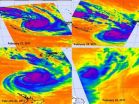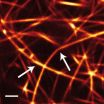(Press-News.org) An AIDS vaccine tested in people, but found to be ineffective, influenced the genetic makeup of the virus that slipped past. The findings suggest new ideas for developing HIV vaccines.
The results were published Feb. 27 in Nature Medicine.
This is the first evidence that vaccine-induced cellular immune responses against HIV-1 infection exert selective pressure on the virus. "Selective pressure" refers to environmental demands that favor certain genetic traits over others.
The senior author of the multi-institutional study is Dr. James I. Mullins, University of Washington (UW) professor of microbiology. The research team analyzed the genome sequences in HIV-1 isolated from 68 newly infected volunteers in the STEP HIV-1 vaccine trial. Mullins and the other principal researchers who carried out this study were not involved in the STEP trial.
The STEP trial was a double-blind, Phase 2B test-of-concept of a Merck HIV-1 subtype B vaccine. The vaccine, MRKAd5, was designed to make the body produce infection-fighting white blood cells, commonly called killer T-cells, that could recognize and target specific parts of HIV-1 known as Gag, Pol and Nef.
The STEP trial was conducted at 34 North American, Caribbean, South American and Australian locations where the HIV-1 subtype B was the predominant virus in the local HIV-infected populations. The trial enrolled 3,000 participants.
Preliminary tests indicated the vaccine was encouraging the appearance of the desired virus-attacking cells. More than 75 percent of vaccinated participants produced HIV-1 specific T cells.
Nevertheless, this response to the vaccine did not predict protection. The trial failed. Immunizations were halted, Mullins recalled, after the first interim analysis indicated that the vaccine neither prevented HIV-1 infection nor reduced the load of virus in the body.
"Even though the T-cell responses were not sufficient to prevent infection," Mullins said, "we were interested in whether the vaccine-elicited T-cells had any impact on those strains of HIV-1 that established infections in the study subjects."
The research team tested for a "sieve effect," which, Mullins explained, occurs when a vaccine successfully blocks some strains of virus and not others. The researchers wanted to know, What are the genetic characteristics of those breakthrough viruses that slipped past the immunization barrier erected by the MRKAd5 vaccine?
The research team isolated strains of HIV-1 from both vaccine and placebo recipients in the study, and compared the genetic sequences of the strains. This would help researchers to determine if any changes in the "founder virus" – the virus first detected in the infection – might have helped it evade the vaccine-induced immune response and take hold in the vaccinated individuals.
The researchers identified potential T-cell targets in the protein-producing regions of the founder virus genetic sequences and compared these to the virus protein-targets of the vaccine – Gag, Pol and Nef. The researchers found that the distances for these viral genetic sequences were greater for the viruses taken from the vaccinated individuals, compared to those from the placebo recipients.
The most significant virus genetic site distinguishing vaccine from placebo recipients was in the region known as Gag-84, which was encompassed by several of the viral segments targeted by the vaccine.
Moreover, the researchers said that the extended divergence between the viruses from the vaccinated and the placebo groups was confined only to the sequences for the proteins targeted by the vaccine components (Gag, Pol and Nef) and was not found in other HIV-1 protein sequences. The influence of the vaccine on the virus genotype, Mullins said, was subtle.
Mullins and his team, as well as their collaborators from the STEP trials studies, are doing similar studies of the genetic impact of the Thailand vaccine RV144 on the AIDS virus. The RV144 vaccine was the first to show some probable effectiveness, but its efficacy was not great enough to put it to more general use.
The researchers added that their findings on breakthrough viruses suggest that new vaccines should be designed to put selective pressure on the virus in a controlled manner.
Such a vaccine, Mullins said, should select for genetic mutations in regions of the virus known to be associated with viral control and should avoid selecting for strains that can either escape the immune defense or act as decoys to fool the immune system.
The researchers propose a goal for new designs of vaccines aimed at inducing killer T-cell responses: corner the virus into assuming forms that debilitate it. This would make the infecting virus fitness-impaired – unable to adapt, reproduce in great numbers and cause disease progression.
"Despite the sad results of the STEP trial," Mullins said, "it has provided clues to ways for science to go forward in the search for an HIV vaccine.
INFORMATION:
The research was supported by a grant from the U.S. Public Health Service.
In addition to Mullins, others on the research team were: Morgane Rolland, Sodsai Tovanabutra, Allan C. decamp, Nicole Frahm, Peter B. Gilbert, Eric Sanders-Buell, Laura Heath, Craig A. Margaret, Meera Bose, Andrea Bradfield, Annemarie O'Sullivan, Jacqueline Crossler, Teresa Jones, Marty Nau, Kim Wong, Hong Zhoa, Dana N. Raugi, Stephanie Sorensen, Julia Stoddard, Brandon S. Maust, Wenjie Deng, John Hural, Sheri Dubey, Nelson L. Michael, John Shiver, Lawrence Corey, Fusheng Li, Stephen G. Self., Jerome Kim, Susan Buchbinder, Danilo R. Casimiro, Michael N. Robertson, Ann Duerr, M. Juliana McElrath, and Francine E. McCutchan.
The researchers are from these institutions: Department of Microbiology, University of Washington; U.S. Military Research Program, Rockville, Md.; Vaccine and Infectious Disease Institute, Fred Hutchison Cancer Research Center; Merck Research Laboratories, West Point, Pa.; San Francisco Department of Health, and the Bill & Melinda Gates Foundation.
For first time, scientists show an HIV vaccine impacts the genetic makeup of the virus
Results suggest new vaccine strategies to debilitate viruses by tapping into this response
2011-03-02
ELSE PRESS RELEASES FROM THIS DATE:
NASA tracks the brief life of Tropical Cyclone Atu in the southern Pacific
2011-03-02
Tropical Cyclone Atu had a brief but memorable life last week, and NASA's Atmospheric Infrared Sounder (AIRS) instrument that flies aboard NASA's Aqua satellite captured a day-by-day look at its growth and death.
AIRS provides infrared images of atmospheric phenomena, oceans and land areas around the world. Basically, infrared data takes the temperature of these things. When NASA's Aqua satellite flew over Tropical Cyclone Atu from February 21 through the 25 it saw thunderstorm cloud tops grow colder as the clouds grew higher and thunderstorms became more powerful. When ...
NASA's Glory Satellite scheduled for launch March 4
2011-03-02
WASHINGTON -- NASA's Glory spacecraft is scheduled for launch on Friday, March 4. Technical issues with ground support equipment for the Taurus XL launch vehicle led to the scrub of the original Feb. 23 launch attempt. Those issues have been resolved.
The March 4 liftoff from Vandenberg Air Force Base, Calif., is targeted for 5:09:43 a.m. EST, in the middle of a 48-second launch window. Spacecraft separation occurs 13 minutes after launch.
Data from the Glory mission will allow scientists to better understand how the sun and tiny atmospheric particles called aerosols ...
Tanning bed exposure can be deadly when complicated by medication reactions
2011-03-02
INDIANAPOLIS – Tanning bed exposure can produce more than some tanners may bargain for, especially when they self-diagnose and use the radiation to treat skin eruptions, according to research conducted by the Indiana University School of Medicine Department of Dermatology.
"There are many reasons to be cautious of tanning bed radiation but some people use tanning beds to 'self-treat' skin eruptions," said Jeffrey B. Travers, M.D., Ph.D., senior author of a study published online in the Archives of Dermatology. "If the skin eruption is eczema or even psoriasis, a tanning ...
Discovery of source of glycogen 'manufacturing' errors sheds light on fatal disease
2011-03-02
Indiana University scientists have solved a perplexing mystery regarding one of the body's main energy storage molecules, in the process shedding light on a possible route to treatment of a rare but deadly disease in teenagers.
The disease occurs when a genetic mutation causes excessive amounts of phosphate to build up in glycogen. Glycogen is a chain-like molecule the body uses to temporarily store glucose when it's not needed to provide energy for cellular activities. The excess phosphate causes unnatural glycogen structures to appear in the body, including the brain, ...
Emergency mental health lessons learned from Continental Flight 3407 disaster
2011-03-02
BUFFALO, N.Y. -- When a disaster's physical evidence is gone -- debris removed, shooter arrested, ashes cold -- the psychological effects of the disaster on emergency responders and civilians involved still may burn.
Emergency mental health, a field often overlooked in the chaos, is a vital component of any disaster response, but may not be well represented in emergency preparedness planning.
Trained mental health responders to the Continental Flight 3407 disaster outside Buffalo in 2009 share their lessons learned on mental health preparedness in an article that ...
Queen's University professor uses nanotechnology to prolong machine and engine life
2011-03-02
Guojun Liu has discovered a way to use nanotechnology to reduce friction in automobile engines and machines.
"The technology should be useful in a wide range of machineries other than automobile engines," says Dr. Liu, a professor in the Department of Chemistry and an expert in polymer synthesis. "If implemented industrially, this nanotechnology should help prolong machine life and improve energy efficiency."
Dr Liu's team prepared miniscule polymer particles that were only tens of nanometers in size. These particles were then dispersed in automobile engine base oils. ...
Relaxation leads to lower elasticity
2011-03-02
This press release is available in German.
Many materials, when observed over a sufficiently long period of time, show changes in their mechanical properties. The exact course of these developments depends on the underlying microscopic mechanisms. However, the microscopic structure and the complexity of the systems make direct observation extremely difficult.
That is why a team led by Professor Andreas Bausch from the Chair of Cellular Biophysics resorted to a model system that can be precisely controlled using actin filaments, a biopolymer that, among other things, ...
The dusty disc of NGC 247
2011-03-02
The spiral galaxy NGC 247 is one of the closest spiral galaxies of the southern sky. In this new view from the Wide Field Imager on the MPG/ESO 2.2-metre telescope in Chile large numbers of the galaxy's component stars are clearly resolved and many glowing pink clouds of hydrogen, marking regions of active star formation, can be made out in the loose and ragged spiral arms.
NGC 247 is part of the Sculptor Group, a collection of galaxies associated with the Sculptor Galaxy (NGC 253, also shown in eso0902 - http://www.eso.org/public/news/eso0902/ - and eso1025 - http://www.eso.org/public/news/eso1025/). ...
Effectiveness of wastewater treatment may be damaged during a severe flu pandemic
2011-03-02
Existing plans for antiviral and antibiotic use during a severe influenza pandemic could reduce wastewater treatment efficiency prior to discharge into receiving rivers, resulting in water quality deterioration at drinking water abstraction points.
These conclusions are published this week (2 March 2011) in a new paper in the journal Environmental Health Perspectives, which reports on a study designed to assess the ecotoxicologic risks of a pandemic influenza medical response.
The research was carried out by a team from the Centre for Ecology & Hydrology (UK), the Institute ...
Research suggests alcohol consumption helps stave off dementia
2011-03-02
Experts agree that long-term alcohol abuse is detrimental to memory function and can cause neuro-degenerative disease. However, according to a study published in Age and Ageing by Oxford University Press today, there is evidence that light-to-moderate alcohol consumption may decrease the risk of cognitive decline or dementia.
Estimates from various studies have suggested the prevalence of alcohol-related dementia to be about 10% of all cases of dementia. Now researchers have found after analyzing 23 longitudinal studies of subjects aged 65 years and older that the impact ...
LAST 30 PRESS RELEASES:
Why nail-biting, procrastination and other self-sabotaging behaviors are rooted in survival instincts
Regional variations in mechanical properties of porcine leptomeninges
Artificial empathy in therapy and healthcare: advancements in interpersonal interaction technologies
Why some brains switch gears more efficiently than others
UVA’s Jundong Li wins ICDM’S 2025 Tao Li Award for data mining, machine learning
UVA’s low-power, high-performance computer power player Mircea Stan earns National Academy of Inventors fellowship
Not playing by the rules: USU researcher explores filamentous algae dynamics in rivers
Do our body clocks influence our risk of dementia?
Anthropologists offer new evidence of bipedalism in long-debated fossil discovery
Safer receipt paper from wood
Dosage-sensitive genes suggest no whole-genome duplications in ancestral angiosperm
First ancient human herpesvirus genomes document their deep history with humans
Why Some Bacteria Survive Antibiotics and How to Stop Them - New study reveals that bacteria can survive antibiotic treatment through two fundamentally different “shutdown modes”
UCLA study links scar healing to dangerous placenta condition
CHANGE-seq-BE finds off-target changes in the genome from base editors
The Journal of Nuclear Medicine Ahead-of-Print Tip Sheet: January 2, 2026
Delayed or absent first dose of measles, mumps, and rubella vaccination
Trends in US preterm birth rates by household income and race and ethnicity
Study identifies potential biomarker linked to progression and brain inflammation in multiple sclerosis
Many mothers in Norway do not show up for postnatal check-ups
Researchers want to find out why quick clay is so unstable
Superradiant spins show teamwork at the quantum scale
Cleveland Clinic Research links tumor bacteria to immunotherapy resistance in head and neck cancer
First Editorial of 2026: Resisting AI slop
Joint ground- and space-based observations reveal Saturn-mass rogue planet
Inheritable genetic variant offers protection against blood cancer risk and progression
Pigs settled Pacific islands alongside early human voyagers
A Coral reef’s daily pulse reshapes microbes in surrounding waters
EAST Tokamak experiments exceed plasma density limit, offering new approach to fusion ignition
Groundbreaking discovery reveals Africa’s oldest cremation pyre and complex ritual practices
[Press-News.org] For first time, scientists show an HIV vaccine impacts the genetic makeup of the virusResults suggest new vaccine strategies to debilitate viruses by tapping into this response





